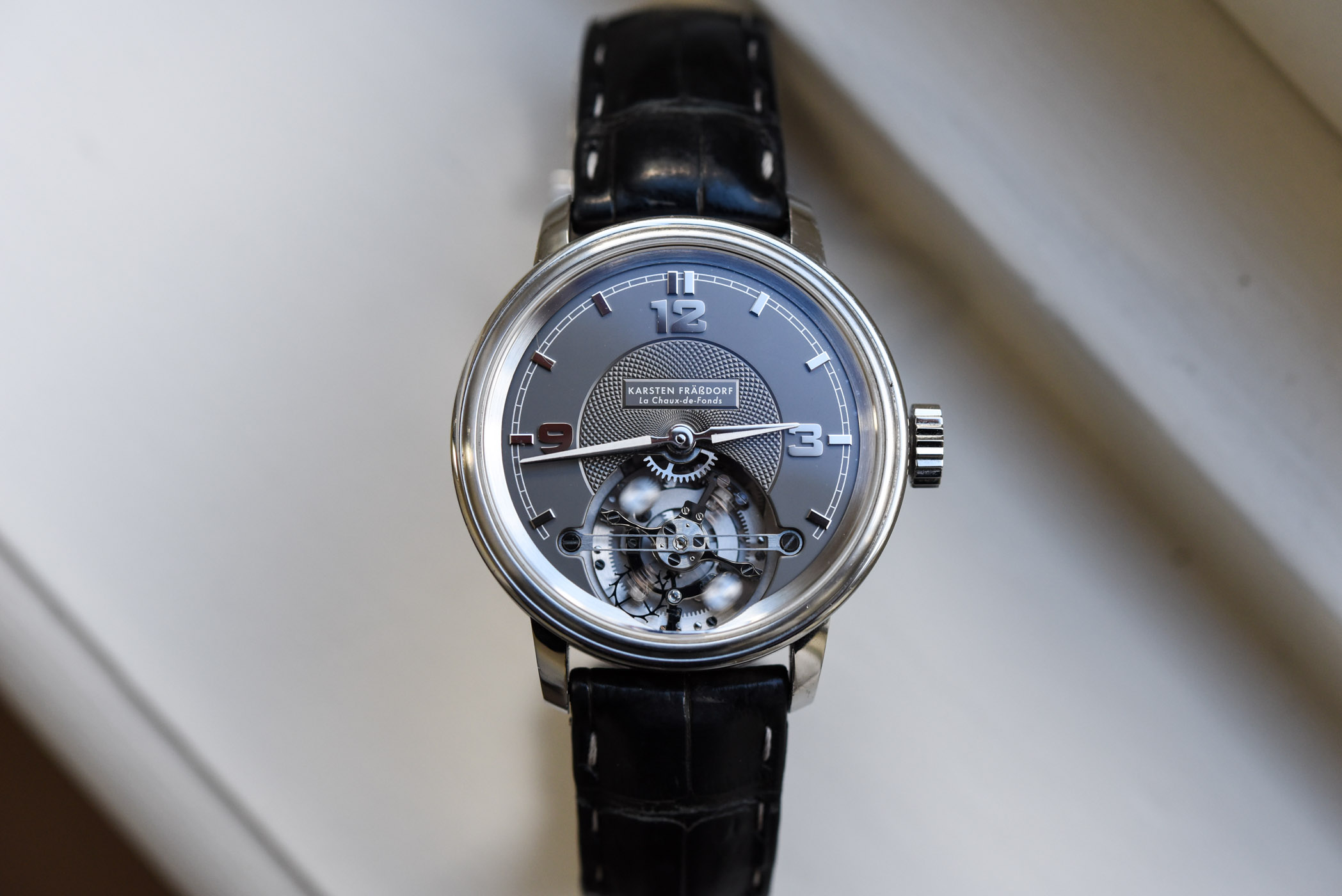Sitting at the Workbench with Karsten Frassdorf and an In-Depth Look at the Spirograph Tourbillon’s Calibre 360
A journey inside the complexities of Frassdorf's calibre 360.

If you are a regular reader of Monochrome-watches you might be familiar with Montres KF’s Spirograph, a wristwatch that can withstand shocks up to 5,000G and magnetic fields up to 1,000 Gauss. Inside the 45mm Spirograph is the calibre 360, a hand-wound movement regulated by an eye-catching and unique oversized tourbillon. We sat at the workbench with the German master watchmaker to disassemble the calibre 360 and go in-depth with this very special movement.
The movement architecture
The calibre 360 is a large movement with a pillar architecture. All parts are fitted in between two plates secured together with pillars, instead of having a plate and bridges screwed tightly together. This traditional architecture is inspired by that of marine chronometers. Beyond the nod to horological tradition and classic precision watchmaking, this solution also offers enhanced shock resistance, among other reasons because it allows for a reduction in the weight of the movement. However, this is a demanding solution requiring great manufacturing precision.
To make the movement anti-magnetic, critical parts that should steer clear of magnetism have been fashioned out of non-magnetic materials.
Karsten Frassdorf also uses pins to secure all parts together, ensuring that these are perfected positioned. It also offers optimal shock resistance as all parts are tightly held together. The movement’s efficiency is also enhanced thanks to the perfect positioning of all parts. But again, this solution requires super precise manufacturing. In a similar fashion, instead of feet, the dial is held in place by 3 pins and screws.

Chronometry and movement efficiency are major focuses for Karsten Frassdorf. For instance, he has opted for CuBe wheels for optimal tribological efficiency (the hardness of CuBe is ~380 Vickers versus ~200 for brass). Overall, the movement’s efficiency is of 75% according to the German Master watchmaker (Editor’s note, mechanical efficiency measures the effectiveness of a machine in transforming the energy and power). This allows the calibre 360 to store up to 70 hours of power reserve on just one barrel and to use a large balance with high inertia, which is better in terms of chronometry.
The Tourbillon
The first thing to catch the eye with the Spirograph is its large one-minute tourbillon ticking at a slow, mesmerizing 18,000 vibrations per hour. It is 16mm in diameter with a moment of inertia of 60. Its original design features no balance rim but two large, heavy weights. It is fitted with 4 regulating screws: the large screws are for classification, the smaller ones are for fine-adjustment (one turn equals 6 seconds/day).
Fashioned out of Straumann alloy, the hairspring has two terminal curves: the inner curve is a Grossman curve and the outer a Phillips (or Breguet) curve. This improves the hairspring concentric development. As it breathes optimally, the isochronism of the balance (editor’s note: having a constant period regardless of the amplitude) is improved. This unique combination is extremely delicate to manufacture and can only be crafted/shaped by hand.
A clever construction, the tourbillon is easy to put in place thanks to the fixed gear around the tourbillon opening. This fixed toothing is held in place by 4 pins to ensure optimal positioning and efficiency. The jewel bearing for the tourbillon is set with a removable chaton to allow for simple aftersales service operations.
Barrel
Just like for the tourbillon jewel bearing, the barrel features a chaton to allow for easy operations (handshake or jewel lubrication). The mainspring bridle is a T type (or Wittnauer type). This allows for the optimal concentric development of the spring inside the barrel’s drum, enhancing its efficiency.
The barrel is fitted with a Geneva stop work. This device allows operating within the optimum range of the barrel to deliver a constant force to the regulator. The Geneva stop work consists in a gear in the form of a cross with several arms, all with a concave end except for one. It works with another wheel with one finger fixed on the barrel arbour. One arm with a convex end prevents the arbour from rotating when it encounters the finger piece. The Maltese cross will also stop the running of the watch before the barrel unwinds completely. It, therefore, allows a certain number of turns of the barrel only. As a consequence, only a part of the development of the mainspring is used, which corresponds to its optimum operating range, avoiding high and low torque – 44 hours in the case of the Spirograph
The keyless works
An original solution, the keyless works are a built-in a module, ensuring ease of servicing. The original gear arrangement aims at ensuring a smooth winding and long-term reliability.
For more details about the watch and to see how it wears on a daily basis, please consult our review here. More details on www.montres-kf.com.















1 response
I’m liking these independent articles. Looking forward to you maybe doing Dornbluth, or Bexei.